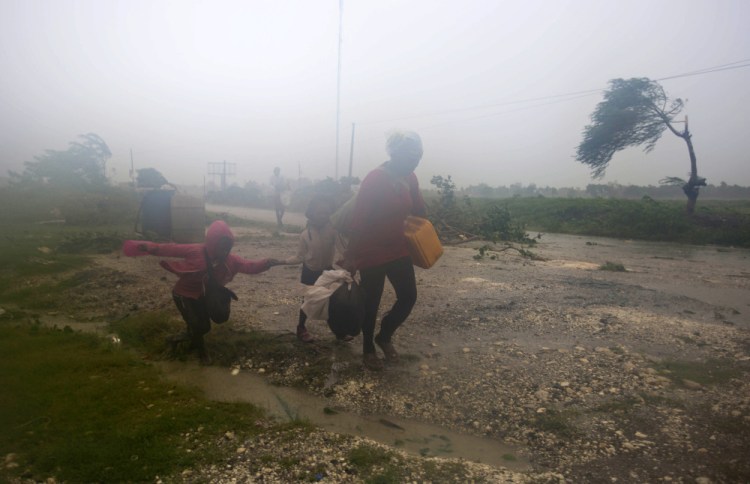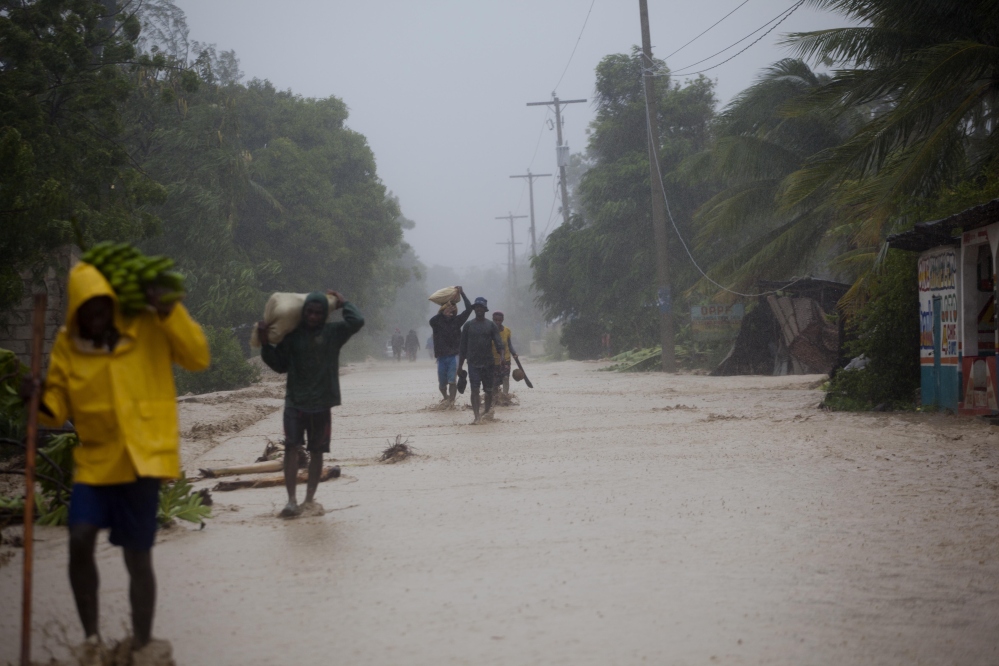PETIT-GOAVE, Haiti — Hurricane Matthew headed into the southern Bahamas with its dangerous winds early Wednesday, leaving behind widespread damage and human suffering in Haiti’s poor, rural southwestern peninsula, where the hardest-hit area was cut off by flooding.
At least 11 deaths had been blamed on the powerful storm during its weeklong march across the Caribbean, five of them in Haiti. But with a key bridge washed out, roads impassable and phone communications down, the western tip of Haiti was isolated and there was no word on dead and injured.
Hours after Matthew swept onto the remote area with 145 mph winds, government leaders said they weren’t close to fully gauging the impact in the vulnerable, flood-prone country where less powerful storms have killed thousands.
“What we know is that many, many houses have been damaged. Some lost rooftops and they’ll have to be replaced while others were totally destroyed,” Interior Minister Francois Anick Joseph said.
After making landfall Tuesday night near Cuba’s sparsely populated eastern tip with no immediate reports of major damage, the center of the slightly weakened but still powerful Category 4 storm moved back over open waters.
At 11 p.m. EDT Tuesday, it had maximum sustained winds of 130 mph and was heading north at 8 mph, taking aim at the Bahamas.
Bahamas Prime Minister Perry Christie voiced concern about the potential impact on the sprawling archipelago off Florida’s east coast.
“We’re worried because we do not control nature,” he said.
There was growing concern on the U.S. East Coast, which was expected to come under threat after Matthew made a two-day surge up the length of the Bahamas. People raced to supermarkets, gas stations and hardware stores, buying up groceries, water, plywood, tarps, batteries and propane.
South Carolina Gov. Nikki Haley said she would issue an evacuation order Wednesday so 1 million people would have time to leave the coast. The Red Cross put out a call for volunteers there.
Florida Gov. Rick Scott urged coastal residents to prepare for the possibility of a direct hit and line up three days’ worth of food, water and medicine. The White House said relief supplies were being moved to emergency staging areas in the Southeast.
In Haiti, where international aid efforts were stymied Tuesday because of the lack of access to the hardest-hit areas, many residents of flooded areas seen by Associated Press reporters were wading through shin-high waters.
Muddy rivers and tributaries continued to rise as water flowed down hillsides and mountains, making more flash floods and mudslides possible even Matthew tracked away from the country.
Matthew was at one point a Category 5 storm, making it the most powerful hurricane in the region in nearly a decade. It blew ashore around dawn in Haiti, the poorest country in the Western Hemisphere and a place where many people live in shacks of wood or concrete blocks.
Mourad Wahba, U.N. secretary-general’s deputy special representative for Haiti, said at least 10,000 people were in shelters and hospitals were overflowing and running short of water. Wahba’s statement called the hurricane’s destruction the “largest humanitarian event” in Haiti since the devastating earthquake of January 2010.
Surging waters ripped away a bridge in the flooded town of Petit Goave, preventing any road travel to the hard-hit southwest. Local radio reported water shoulder high in parts of the southern city of Les Cayes.
Milriste Nelson, a 65-year-old farmer in the town of Leogane, said neighbors fled when the wind tore away the corrugated metal roof on their home. His own small yard was strewn with the fruit he depends on for his livelihood.
“All the banana trees, all the mangos, everything is gone,” Nelson said as he boiled breadfruit over a charcoal fire. “This country is going to fall deeper into misery.”
Haitian authorities had tried to evacuate people from the most vulnerable areas ahead of the storm, but many were reluctant to leave their homes. Some sought shelter only after the worst was already upon them.
Before cellular communications went out in the southwestern town of Jeremie, one resident described seeing panicked people who hadn’t evacuated frantically seeking shelter.
“Some people who lived by the sea are walking with their things through flooded streets looking for somewhere to go,” said Iralien St. Louis, a photographer who was hunkered down at his home.
Rainfall totals were predicted to reach 15 to 25 inches in Haiti, with up to 40 inches in isolated places.
Send questions/comments to the editors.




Success. Please wait for the page to reload. If the page does not reload within 5 seconds, please refresh the page.
Enter your email and password to access comments.
Hi, to comment on stories you must . This profile is in addition to your subscription and website login.
Already have a commenting profile? .
Invalid username/password.
Please check your email to confirm and complete your registration.
Only subscribers are eligible to post comments. Please subscribe or login first for digital access. Here’s why.
Use the form below to reset your password. When you've submitted your account email, we will send an email with a reset code.